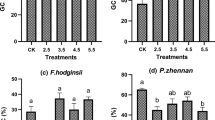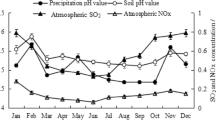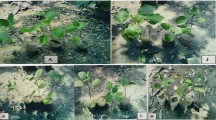Abstract
Over the past decade, the extent and magnitude of acid rain in Vietnam and other Asian countries have become more apparent. In this study, the effect of simulated acid rain (pH 5.0, 4.0, and 3.0) and control treatment (pH 6.0) are observed for three species Brassica integrifolia, Brassica rapa, and Brassica juncea in Hanoi. The pot experiment was conducted for 42 days and arranged according to a randomized complete block design (RCBD), replicated 3 times with acid rain exposure being supplied every 4 days. The results show that acid rain causes direct damage to leaves. Observations reveal white spots on leaves; leaves getting discolored and gradually turning yellow, curling leaf marginals, and turning dark blue, with the most severe symptoms being necrotic leaves. Parameters of the shoot and root length, leaf area, biomass, and chlorophyll content all decrease as pH drops. However, the accumulation of proline content in leaves tends to increase with greater acidity. In conclusion, Brassica rara has the highest resistance capability to acid rain compared with Brassica integrifolia and Brassica juncea, especially its proline content is the highest at pH 3.0 in three Brassicaceae species.




Similar content being viewed by others
Data availability
Original data are available on requests from the corresponding author.
References
United States Geological Survey (USGS) (2013) Acid rain: do you need to start wearing a rain hat? http://ga.water.usgs.gov/edu/acidrain.html
Baskin VN (2003) Acid deposition. In: Environmental Chemistry: Asian Lessons. Springer, Dordrecht, 77–114. https://doi.org/10.1007/0-306-48020-4_4
Bassi R, Sharma SS (1993) Proline accumulation in wheat seedlings exposed to zinc and copper. Phytochemistry 33(6):1339–1342. https://doi.org/10.1016/0031-9422(93)85086-7
Bates LS, Waldren RP, Teare ID (1973) Rapid determination of free proline for water stress studies. Plant Soil 39:205–207. https://doi.org/10.1007/BF00018060
Bolan NS, Adriano DC, Curtin D (2003) Soil acidification and liming interactions with nutrient and heavy metal transformation and bioavailability. Advances in Agronomy 78:215–272. https://doi.org/10.1016/S0065-2113(02)78006-1
Burns DA, Aherne J, Gay DA, Lehmann CMB (2016) Acid rain and its environmental effects: recent scientific advances. Atmos Environ 146:1–4. https://doi.org/10.1016/j.atmosenv.2016.10.019
Canfield DE, Farquhar J (2012) The global sulfur cycle. In: Fundamentals of Geobiology, Wiley/Blackwell, Chichester, UK, 49–64. https://doi.org/10.1002/9781118280874.ch5
Caporn SJM, Hutchinson TC (1986) The contrasting response to simulated acid rain of leaf and cotyledon of cabbage (Brassica oleracea L.). New Phytol 103(2):311–324. https://doi.org/10.1111/j.1469-8137.1986.tb00618.x
Chae C, Soo KY, Hee LS (1994) Physiological and morphological responses of Perilla and cucumber to simulated acid rain. Horti Environ Biotechnol 35:587–592
Deng J, Wang X, Wei Z, Wang L, Wang C, Chen Z (2021) A review of NOx and SOx emission reduction technologies for marine diesel engines and the potential evaluation of liquefied natural gas fuelled vessels. Sci Total Environ 766:144319.
Downmore M, Jambwa SD, Kusaziwa KP (2015) Trends in the control of NOx and SOx combustion emissions: implications to the design of fluidised bed combustion operations. J Proc Mech Engg 231(3):1–10. https://doi.org/10.1177/0954408915601296
Dursun A, Yildirim E, Guvenc I, Kumlay AM (2002) Effect of simulated acid rain on plant growth and yield of tomato (Lycopersicon esculentum). Acta Hortic. 579:245–248. https://doi.org/10.17660/ActaHortic.2002.579.40
EANET (Acid Deposition Monitoring Network in East Asia) (2018) Data report on the acid deposition from 2000 to 2018.
EPA (United States Environmental Protection Agency) (2021) Forms of acid deposition. Available at: https://www.epa.gov/acidrain/what-acid-rain [accessed 8 December 2021].
Fan HB, Wang YH (2000) Effects of simulated acid rain on germination, foliar damage, chlorophyll contents and seedling growth of five hard wood species growing in China. For Ecol Manag 126(3):321–329. https://doi.org/10.1016/S0378-1127(99)00103-6
Haradhan KM (2018) Acid rain is a local environment pollution but global concern. Open Science Journal of Analytical Chemistry 3(5):47–55
Hare PD, Cress WA (1997) Metabolic implications of stress-induced proline accumulation in plants. Plant Growth Regul 21:79–102. https://doi.org/10.1023/A:1005703923347
Hayat S, Hayat Q, Alyemeni MN, Wani AS, Pichtel J, Ahmad A (2012) Role of proline under changing environments. Plant Signal Behav 7(11):1456–1466. https://doi.org/10.4161/psb.21949
Hosono T, Nouchi I (1994) Effects of simulated acid rain on growth, yield and net-photosynthesis of several agricultural crops. J Agri Meteorol 50(2):121–127. https://doi.org/10.2480/agrmet.50.121
Kohno Y, Matsumura H, Kobayashi T (1994) Effect of simulated acid rain on the development of leaf injury in tree seedlings. J Japan Soc Air Poll 29(4):206–219. https://doi.org/10.11298/taiki1978.29.4_206
Kumaravelu G, Ramanujam MP (1998) Impact of simulated acidic rain on growth, photosynthetic pigments, cell metabolites and leaf characteristics of green gram. Photosynthetica 35:71–78. https://doi.org/10.1023/A:1006821931577
Lal N, Singh H (2013) The effects of simulated acid rain of different pH-levels on biomass and leaf area in sunflower (Helianthus Annuus). Curr Bot 3(5).
Lal N, Singh H (2015) Effect of simulated acid rain on chlorophyll and carotenoid content of sunflower (Helianthus annuus L.) leaves. J Func Environ Bot 5(1):6–10. https://doi.org/10.5958/2231-1750.2015.00002.5
Lal N (2016) Effects of acid rain on plant growth and development. e-J Sci Technol 11(5):85–101.
Liang J, Mai BR, Zheng YF, Li L, Tang XY, Wu RJ (2008) Effects of simulated acid rain on the growth, yield and quality of rape. Acta Ecol Sin 28(1):274–283
Liu H, Ren X, Zhu J, Wu X, Liang C (2018) Effect of exogenous abscisic acid on morphology, growth and nutrient uptake of rice (Oryza sativa) roots under simulated acid rain stress. Planta 248(3):647–659. https://doi.org/10.1007/s00425-018-2922-x
Ma S, Chen WK, Zhang JE, Shen H (2020) Influence of simulated acid rain on the physiological response of flowering Chinese cabbage and variation of soil nutrients. Plant Soil Environ 66:648–657
Mai BR, Zheng YF, Liang J, Liu X, Li L, Zhong YC (2008) Effects of simulated acid rain on leaf photosynthate, growth, and yield of wheat. Chin J Appl Ecol 19(10):2227–2233
MARD (Ministry of Agriculture and Rural Development) (2006) Rules for testing value of cultivation and use of crops; Ministry of Agriculture and Rural Development (MARD): Hanoi, Vietnam, 80–88.
Mofunanya AAJ, Soonen L (2017) Physiological and morphological responses of Amaranthus hybridus L. (green) to simulated nitric and sulphuric acid rain. Br J Appl Sci Tech 21(4):1–12. https://doi.org/10.9734/BJAST/2017/31863
Murray LT (2016) Lightning NOx and impacts on air quality. Curr Pollution Rep 2:115–133. https://doi.org/10.1007/s40726-016-0031-7
Nawaz R, Ahmad S, Arshad M, Ashraf U, Nawaz MW, Rani M, Anwar MM, Parkpian P (2015) Leaching losses of nutrient cations (K+, Ca2+ and Mg2+) from oxisol and ultisol under different rates of acidic deposition in Thailand. Asian J Chem 27(6):2195–2199. https://doi.org/10.14233/ajchem.2015.18072
Nguyen TKL (2007) Study on the effect of acid rain elements on germination rate, chlorophyll content and photosynthetic intensity of Brassia juncea. J Meteorol Hydrolo 559:54–58
Nguyen TKL, Bui L, Nguyen VT (2006) Experimental research on the effects of acid rain on the growth of Brassia juncea. J Meteorol Hydrolo 547:44–51
Oden S (1976) The acidity problem – an outline of concepts. Water Air Soil Sol 6:137–166. https://doi.org/10.1007/BF00182862
Park JB (2005) Effects of simulated acid rain on the shoot growth and internal tissue of Arabidopsis thaliana. J Life Sci 15(6):889–894. https://doi.org/10.5352/JLS.2005.15.6.889
Pham TTH, Le TC, Do TNA (2013) Study the effect of acid rain on photosynthetic intensity, chlorophyll content and evapotranspiration intensity of Phaseolus vulgaris L. J Sci Vietnam Nat Uni 29(3S):69–74
Pham TTH, Nguyen AT, Do TNA, L Hens (2021) Impacts of simulated acid rain on the growth and the yield of soybean (Glycine max (L.) Merr.) in the mountains of Northern Vietnam. Sustainability 13(9):1–15. https://doi.org/10.3390/su13094980
Posmyk MM, Janas KM (2007) Effects of seed hydropriming in presence of exogenous proline on chilling injury limitation in Vigna radiata L. seedlings. Acta Physiol Plant 29(6):509–517. https://doi.org/10.1007/s11738-007-0061-2
Pragati, Dhaka TS (2006) Effect of acid rain upon growth parameters of Zinnia elegans. Adv Plant Sci 19:435–438
Rady MM, Taha RS, Mahdi AHA (2016) Proline enhances growth, productivity and anatomy of two varieties of Lupinus termis L. grown under salt stress. South Afr J Bot 102:221–227. https://doi.org/10.1016/j.sajb.2015.07.007
Seinfeld JH, Pandis SN (1998) Atmospheric chemistry and physics: From air pollution to climate change. John Wiley and Sons.
Shaukat SS, Khan MA (2008) Growth and physiological responses of tomato (Lycopersicon esculentum Mill.) to simulated acid rain. Pak J Bot 40(6):2427–2435.
Shaukat SS, Shafig N (1998) Effects of simulated acid rain on germination and seedling growth of some wild and cultivated species. Pak J Bio Sci 1:219–222
Silveira MLA, Alleoni LRF, Guiherme LRG (2003) Biosolids and heavy metals in soils. Sci Agric 60(4). https://doi.org/10.1590/S0103-90162003000400029
Singh B, Agrawal M (2004) Impact of simulated acid rain on growth and yield of two cultivars of wheat. Water Air Soil Pol 152:71–80. https://doi.org/10.1023/B:WATE.0000015331.02874.df
Sirohi DS, Khan MAA (2006) Effects of atmospheric pollution as acid rain on growth, chlorophyll content and root nodules of Trifolium alexandrinum L. Crop Res Hisar 32:528–534
Spokes LJ, Jickells TD (2005) Is the atmosphere really an important source of reactive nitrogen to coastal waters? Cont Shelf Res 25(16):2022–2035. https://doi.org/10.1016/j.csr.2005.07.004
Stern AC, Wohlers HC, Boubel RW, Lowry WP (1973) Fundamentals of air pollution. Academic Press
Sullivan TS, Gadd GM (2019) Chapter Three - Metal bioavailability and the soil microbiome. Adv Agron 155:79–120
Taie HA, Abdelhamid M, Dawood M, Nassar R (2013) Pre-sowing seed treatment with proline improves some physiological, biochemical and anatomical attributes of faba bean plants under sea water stress. J Appl Sci Res 9(4):2853–2867
Temple DJ, Lennox RW, Bytnerowicz A, Taylor OC (1987) Interactive effects of simulated acidic fog and ozone on field grown alfalfa. Envir Exp Bot 27(4):409–417. https://doi.org/10.1016/0098-8472(87)90021-9
Thai H, Dang M (2016) A farmer’s friend – techniques for growing and taking care of some vegetables. Hong Duc Publishing, 103.
Wood T, Bormann FH (1974) The effects of artificial acid mist upon growth of Betula alleghaniensis britt. Envir Pollu 7(4):259–268. https://doi.org/10.1016/0013-9327(74)90035-4
Yang M, Tan L, Xu Y, Zhao Y, Cheng F, Ye S, Jiang W (2015) Effect of low pH and aluminum toxicity on the photosynthetic characteristics of different fast-growing eucalyptus vegetatively propagated clones. PLoS ONE 10(6):e0130963. https://doi.org/10.1371/journal.pone.0130963
Acknowledgements
We would like to thank to the Faculty of Environmental Sciences, Faculty of Biology belonging to VNU University of Science for allowing us to use the equipments needed for the experiment in this study. We also would like to express our sincere thanks to Mr. Paul Liew, Environmental Protection Authority, South Australia, for his useful remarks on this manuscript.
Author information
Authors and Affiliations
Contributions
Conceptualization: Ha T.T. Pham., Mai Q. Le.; formal analysis: Ha T.T. Pham., Ly N. Nguyen., Thuy T. Le., Toan K. Tran; investigation: Ha T.T. Pham., Ly N. Nguyen., Thuy T. Le.; methodology: Ha T.T. Pham. and Mai Q. Le.; research administration: Ha T.T. Pham.; validation: Ha T.T. Pham, Toan K. Tran; writing (original draft): Ly N. Nguyen., Ha T.T. Pham., Thuy T. Le; writing (review and editing): Ha T.T. Pham., Toan K. Tran., Mai Q. Le.; final manuscript editing: Ha T.T. Pham. The manuscript was approved for publication by all authors.
Corresponding author
Ethics declarations
Ethics approval.
Not applicable.
Consent to participate.
Not applicable.
Consent for publication.
Not applicable.
Competing interests
The authors declare no competing interests.
Additional information
Responsible Editor: Philippe Garrigues.
Publisher's note
Springer Nature remains neutral with regard to jurisdictional claims in published maps and institutional affiliations.
Rights and permissions
About this article
Cite this article
Pham, H.T.T., Nguyen, L.N., Le, T.T. et al. Impact of simulated acid rain on the growth of three species Brassica integrifolia, Brassica rapa, Brassica juncea in Hanoi, Vietnam. Environ Sci Pollut Res 29, 42090–42101 (2022). https://doi.org/10.1007/s11356-022-19652-7
Received:
Accepted:
Published:
Issue Date:
DOI: https://doi.org/10.1007/s11356-022-19652-7




